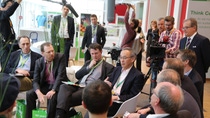Sustainability
What's New
Latest News
Results: 427

BASF invests in increasing production capacity of Neopor® at Ludwigshafen site
BASF is strengthening its styrene value chain at its Ludwigshafen site by expanding the production capacity of Neopor® by 50,000 metric tons per year. This increase is aimed at meeting the growing market demand for the grey insulation material. The start-up of the new production facilities is scheduled for early 2027.

No less and so much more: BASF celebrates 40th birthday of Basotect®, the world’s first melamine resin foam
BASF celebrates the 40th birthday of Basotect®, the world’s first melamine resin foam. It was introduced into the market in 1984 as a flame-retardant alternative to conventional foams used for sound proofing and thermal insulation in construction. Since then, customers have come to appreciate Basotect® for its high performance and versatility: It is available in eight grades for different applications, amongst them the famous cleaning sponge, which simply rubs off the dirt without the help of cleaning agents. The thermoset foam is a symbol of BASF’s innovative power in the foams business unlocking its potential for industries as diverse as construction, automotive, public transport, cleaning, aerospace and renewable energies with a focus on safety and energy efficiency.

Save energy, increase power and efficiency: high-performance PPA by BASF for next-generation IGBT semi-conductors
For next-generation power electronics, BASF has developed a polyphthalamide (PPA) that is especially suited for manufacturing housings of IGBT (insulated-gate bipolar transistor) semi-conductors. Ultramid® Advanced N3U41 G6 addresses the growing demand for high-performance, reliable electronic components for e.g., electric vehicles, high-speed trains, smart manufacturing and the generation of renewable energy. Semikron Danfoss, a global technology leader in power electronics, now uses the BASF PPA as housing in its Semitrans 10 IGBT which can be installed in inverters of photovoltaic and wind energy systems. Due to its outstanding chemical resistance and dimensional stability, the Ultramid® Advanced N grade enhances the robustness, long-term performance and reliability of these IGBTs.

BASF expands its sustainable polyamide portfolio with products with reduced and, for the first time, net zero CO2 footprints
With Ultramid® LowPCF (reduced CO2 footprint/“Product Carbon Footprint”, PCF**) and Ultramid® ZeroPCF* (CO2 footprint of net zero greenhouse gas emissions), BASF launches two new product variants within its polyamide value chain in Europe. Greenhouse gas emissions can be reduced when compared to conventional products. BASF is offering its Ultramid® B brand and the precursor caprolactam as ZeroPCF and LowPCF variants, as well as Ultramid® C as LowPCF option.

Upscaling of green hydrogen production with specialty plastic Ultrason®
Efficient electrolyzers are key in advancing the green hydrogen economy. For the development of larger, more efficient and durable electrolyzers, BASF offers a unique partnership to the energy sector: a tailored portfolio of polyarylethersulfones (PSU, PESU, PPSU) for components in water electrolyzers used for producing green hydrogen – combined with application know-how and reliable local technical support for part design. Backed by BASF’s deep understanding of complex injection-molding applications and membrane casting, BASF helps customers in upscaling electrolyzer technology, thus pushing the transformation to clean energy. BASF’s portfolio for electrolyzer parts includes Ultrason® grades for frames, gaskets and separator membranes. This can be experienced first-hand at the BASF booth at Fakuma 2024, Germany where an electrolyzer frame sample will be exhibited.



